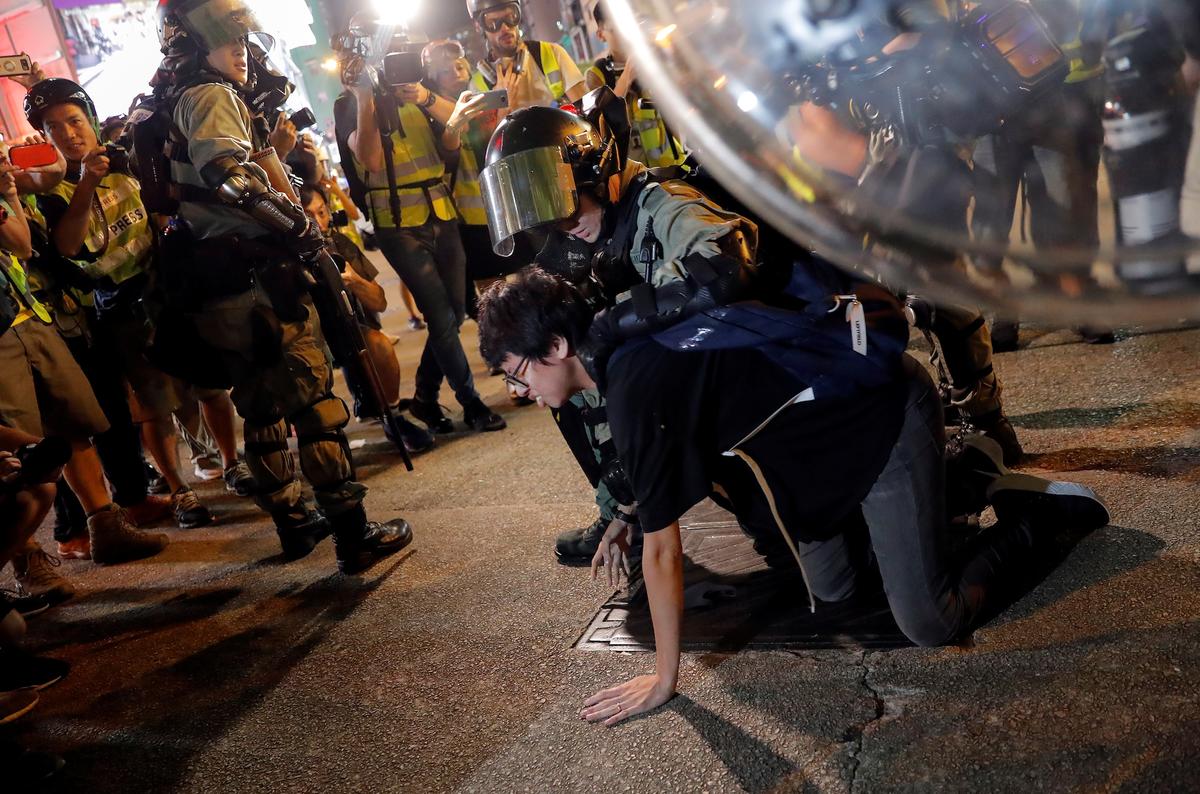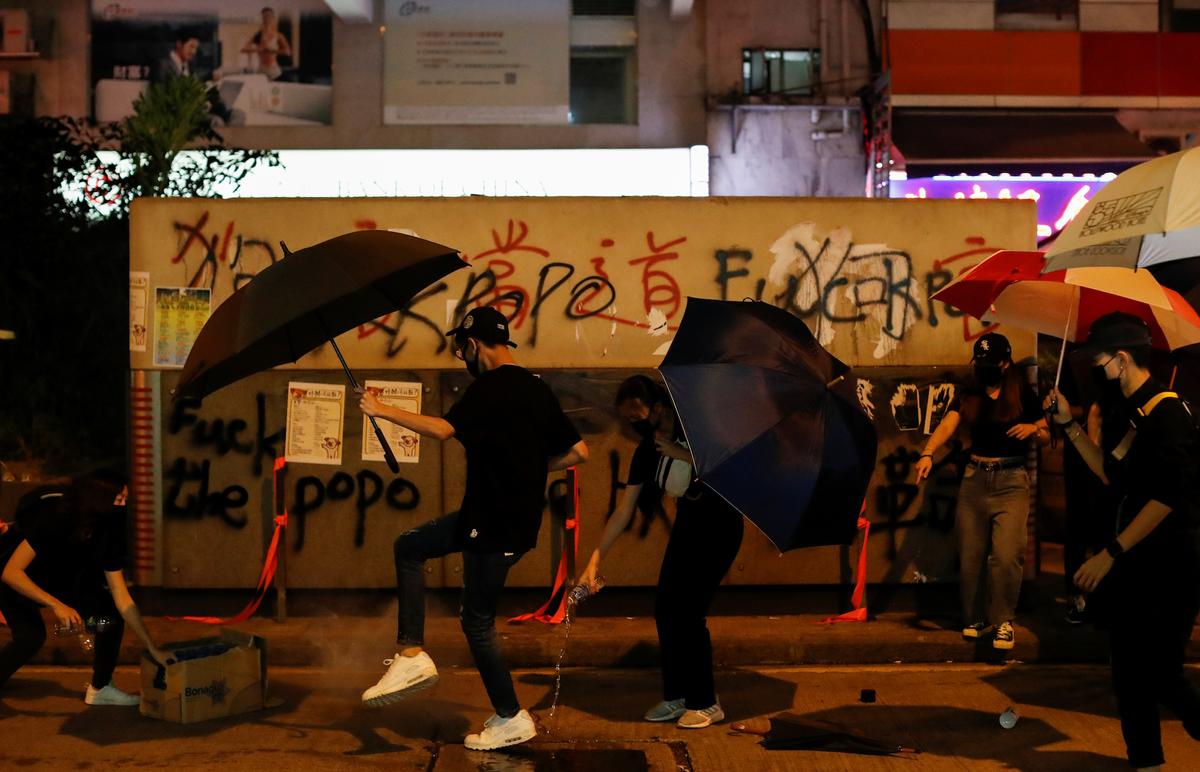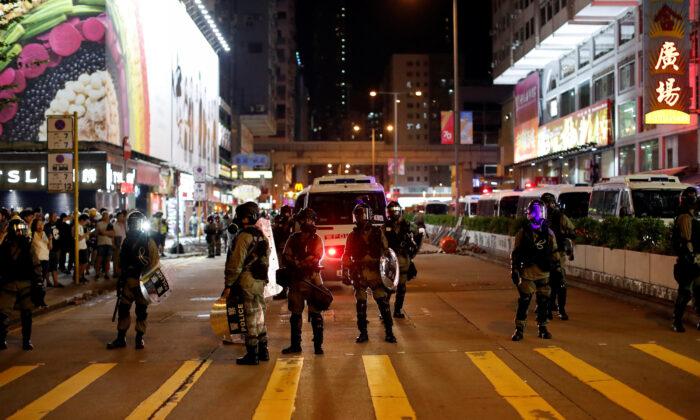HONG KONG—Hong Kong police took to the streets on the night of Oct. 7 in an apparent show of force in a district that has seen some of the most violent clashes with protesters in recent months, but retreated after a confrontation with angry residents.
Riot police arrived in vans and began marching down Nathan Road, in Mong Kok, some beating their shields, after protesters blocked roads and shone laser lights at a police station.
After a tense stand-off with a crowd of around 150 residents and passers-by who heckled them, the police returned to their vans and drove off to chants of “disband police,” and “Hong Kongers revolt.”
Four months of protests have plunged the former British colony into its worst political crisis in decades.
Many Hongkongers feel police have used excessive force against protesters, many school students and young adults, and are demanding an independent inquiry into their actions.
Police fired tear gas on Monday night outside the Prince Edward metro station in Mong Kok, a working class district across the harbor from the financial center that has been a focal point of past demonstrations, as about 250 protesters gathered, but there was no confrontation.
Elsewhere in the city it was a game of cat and mouse between police and protesters.
Hundreds of protesters gathered in Hong Kong shopping malls during the day demanding “freedom,” but expected street protests failed to materialize in any significant size as the scarred city struggled to recover from violent clashes in recent days.
Tens of thousands of protesters, many families with children, marched peacefully through the center of Hong Kong on Sunday, most wearing face masks in defiance of the threat of a maximum one year in prison for doing so. The rallies later descended into violent clashes with police.

Stations Torched
The introduction of colonial-era emergency powers banning face masks, which protesters use to hide their identity, has sparked some of the most violent clashes in four months of demonstrations.“Before long, unless we are very, very lucky, people are going to get killed, people are going to be shot,” former British governor Chris Patten told Sky News.
“The idea that with public order policing you send police forces out with live ammunition is preposterous,” said Patten Britain’s last governor who presided over the handover of Hong Kong to China in 1997.
Two protesters have been shot, one in the chest and one in the leg. Authorities said the shootings were not intentional but occurred during skirmishes between police and protesters.
Many protesters, police and journalists have been injured in clashes, with police using rubber bullets, tear gas and water cannons against demonstrators, some of whom throw bricks and petrol bombs.
On Monday, Hong Kong’s metro rail system, which typically carries about 5 million passengers a day, was only partially operating due to what authorities said was “serious vandalism” on Sunday night. Some stations were torched in the protests.
Many shops and Chinese banks were also extensively damaged.
Around one-tenth of ATMs were vandalized and cash refills may be delayed in some areas due to public events or security concerns, said the Hong Kong Association of Banks (HKAB).
The Sunday night protests, the second night of violence since the imposition of emergency laws, saw scores of protesters arrested and the first warning from Chinese military personnel stationed in the territory.
What started as opposition to a now-withdrawn extradition bill has grown into a pro-democracy movement against what is seen as Beijing’s increasing grip on the city, which protesters say undermines a “one country, two systems” status promised when Hong Kong returned to Chinese rule.

Internet Restrictions
China’s Hong Kong military garrison warned protesters on Sunday they could be arrested for targeting its barracks with lasers—the first direct interaction between the People’s Liberation Army and protesters.Carrie Lam, the city’s Beijing-backed leader, has said the face mask ban was necessary to end the violence by militant activists. But it has been criticized by human rights groups and the United Nations.
Protesters have been using the encrypted Telegram social media messaging system to co-ordinate their actions. On Monday, a member of Hong Kong’s Executive Council would not rule of internet restrictions to curb demonstrations.
“At this stage, the government will consider all legal means to stop the riots. We would not rule out a ban on the Internet,” Ip Kwok-him, a senior pro-Beijing politician, told Commercial Radio.
Protesters are demanding an independent inquiry into police action. Some protesters said an inquiry, which Patten also called for Lam to allow, was key to ending the protests.






Friends Read Free